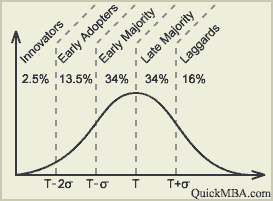Consumers can be grouped according to how quickly they adopt a new product. On the one extreme, some consumers adopt the product as soon as it becomes available. On the other extreme, some consumers are among the last to purchase a new product. As a whole, the new product adoption process can be modeled in the form of a bell-shaped diffusion curve similar to the following:
New Product Diffusion Curve

Defining bins one standard deviation wide about the mean, five different product adoption groups can be defined:
Innovators - well-informed risk-takers who are willing to try an unproven product. Innovators represent the first 2.5% to adopt the product.
Early adopters - based on the positive response of innovators, early adopters then begin to purchase the product. Early adopters tend to be educated opinion leaders and represent about 13.5% of consumers.
Early majority - careful consumers who tend to avoid risk, the early majority adopts the product once it has been proven by the early adopters. They rely on recommendations from others who have experience with the product. The early majority represents 34% of consumers.
Late majority - somewhat skeptical consumers who acquire a product only after it has become commonplace. The late majority represents about 34% of consumers.
Laggards - those who avoid change and may not adopt a new product until traditional alternatives no longer are available. Laggards represent about 16% of consumers.
For this discussion, the term "consumers" represents both individuals and organizations.
The rate of adoption depends on many factors, including:
- perceived benefits over alternative products
- communicability of the product benefits
- price and ongoing costs
- ease of use
- promotional effort
- distribution intensity
- perceived risk
- compatibility with existing standards and values
- divisibility (the extent to which a new product can be tested on a limited basis)
Even if a product offers high value to the customer, the firm nonetheless faces the challenge of convincing potential customers to try the product and eventually to adopt it. The product diffusion curve is partly responsible for the product life cycle, which calls for different management strategies that depend on the product's stage in the life cycle.
source: http://www.quickmba.com/marketing/product/diffusion/
2 comments:
it think it only works for products which have less competitors, for products which ranks high in the minds of customers this adoption rate becomes slows.
This bell curve is most important for those firms which love to innovate and produce new products. They should keep in mind the percentage of people who will adopt their product early on and may give it a boost.
Post a Comment